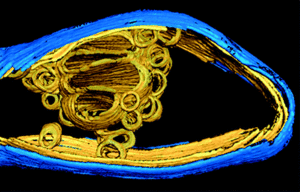Blastochloris
Classification
Bacteria; Proteobacteria; Alphaproteobacteria; Rhizobiales; Hyphomicrobiaceae; Blastochloris
Genus Species
Blastochloris viridis
Description and Significance
Blastochloris virdis is a purple non-sulfur alphaproteobacteria. The proteobacteria are a large, metabolically diverse bacterial phyla consisting of gram-negative organisms. [3] This organism is a photoheterotroph, much like others of its class the proteobacteria. It absorbs light around the wavelength of 400 nm and 1,000nm, resulting in its purple color. It has one of the simplest photosynthetic systems, composed of just one light-harvesting complex surrounding the reaction center. [2] The light-harvesting complex is photosytem II. [3] Its simplicity has lead to its usage in the study of plant biochemistry and pathways. One landmark study in 1989 regarding the structure of the light-harvesting complexes feautured Blastochloris viridis and has since contributed to a general understanding of the reaction center's present in all oxygenic phototrophs, as well as how they acclimate to alterations in light intensity and quality. [4]
Structure, Metabolism, and Life Cycle
Blastochloris viridis is gram-negative alphaproteobacteria and therefore does not contain a thick wall of peptidoglycan. It has two outermembranes, one composed of a thin layer of peptidoglycan and the other of polysaccharides. The organism is a faculative anaerobe. In the presence of oxygen it acts as a heterotroph, obtaining carbon sources from other life forms around it. In anaerobic conditions, it becomes a photoheterotroph, obtaining energy from light and processing it through reaction centers within the membranes in order to form carbon. [2] The alphaproteobacteria in general carry out a wide variety of metabolism: Photosynthesis, Nitrogen Fixation, Ammonia oxidation, and Methylotrophy. [5]
Ecology and Pathogenesis
Alphaproteobacteria are important parts of samples obtained from the environment. Can typically be found in water and soil samples. Often many of the beta subtypes are found as endosymbionts with other organisms, particularly plants.
Alphaproteobacteria contain a diverse range of species, and although Blastochloris viridis is not particularly harmful, others within its class can cause disease such as: Agrobacterium causing gall tumors in plants.
References
[1] http://www.ncbi.nlm.nih.gov/Taxonomy/ [2] Photosynthetic System in Blastochloris viridis Revisited Marina Konorty, Vlad Brumfeld, Andre Vermeglio, Nava Kahana, Ohad Medalia, and Abraham Minsky Biochemistry 2009 48 (22), 4753-4761 [3]3Slonczewski, J. L., & Foster, J. W. (n.d.). Microbiology: An Evolving Science (Vol. 2nd). W.W. Norton & Company. [4]Niederman, Robert A. "Membrane development in purple photosynthetic bacteria in response to alterations in light intensity and oxygen tension." Photosynthesis research (2013) [5] http://drstaiger.com/sitebuildercontent/sitebuilderfiles/alphaproteobacteria.ppt
Author
Page authored by Samantha Landvick, student of Mandy Brosnahan, Instructor at the University of Minnesota-Twin Cities, MICB 3301/3303: Biology of Microorganisms.

